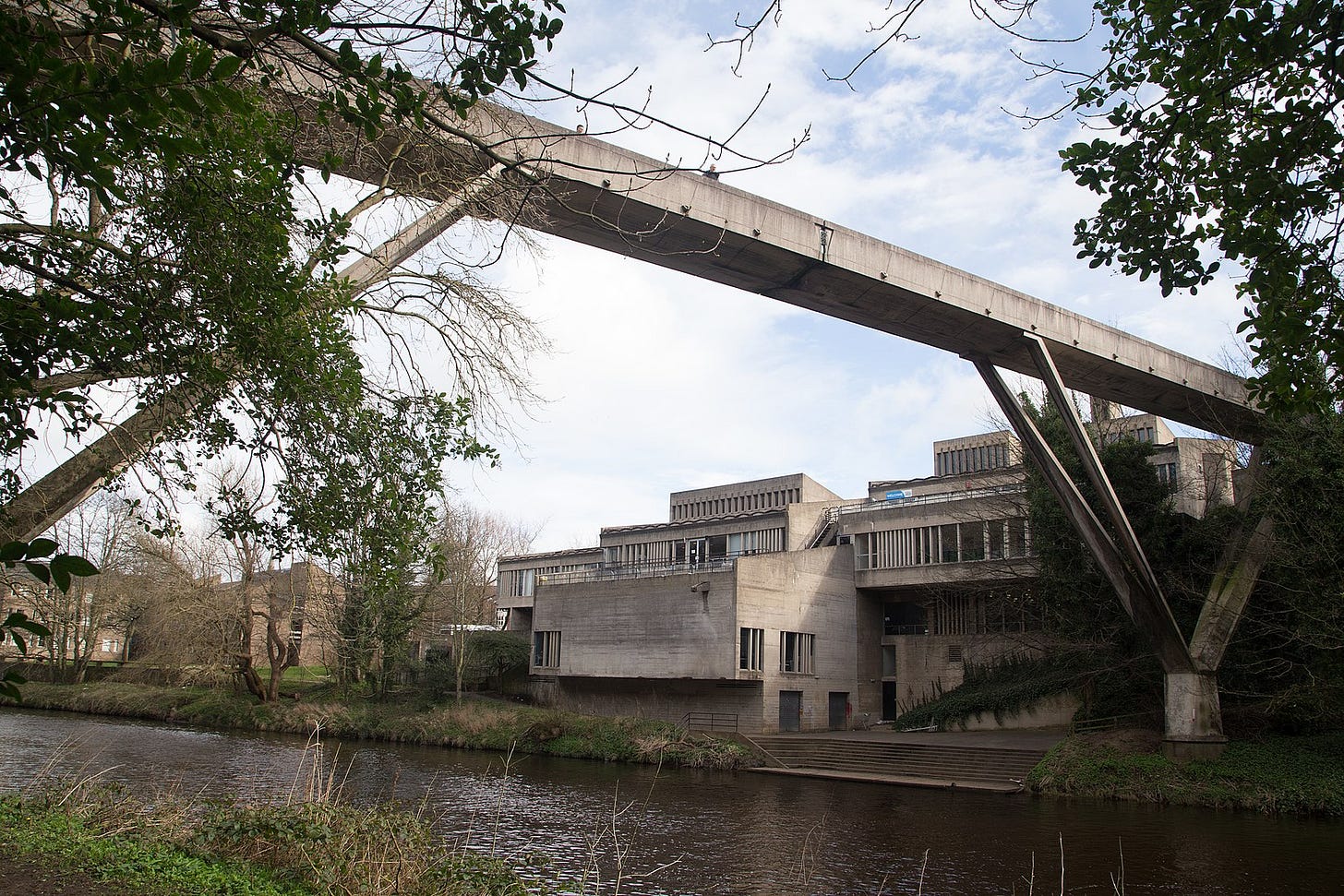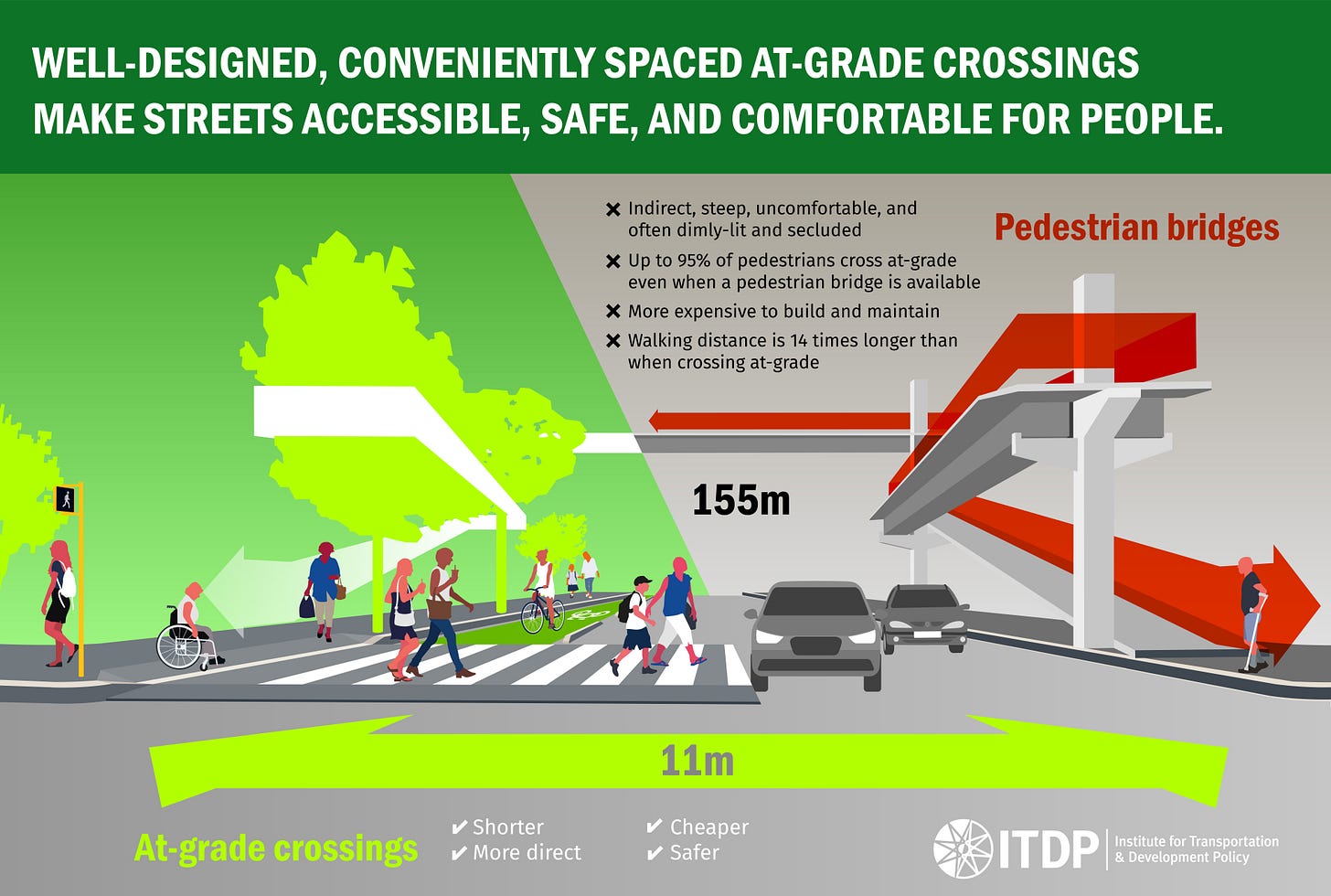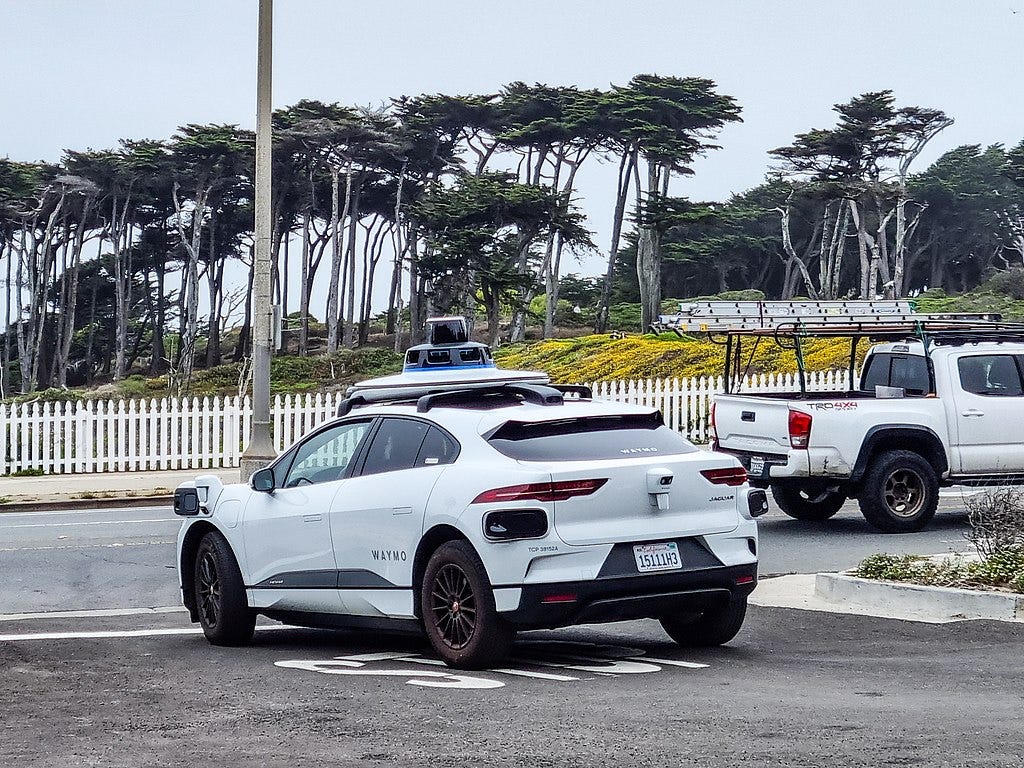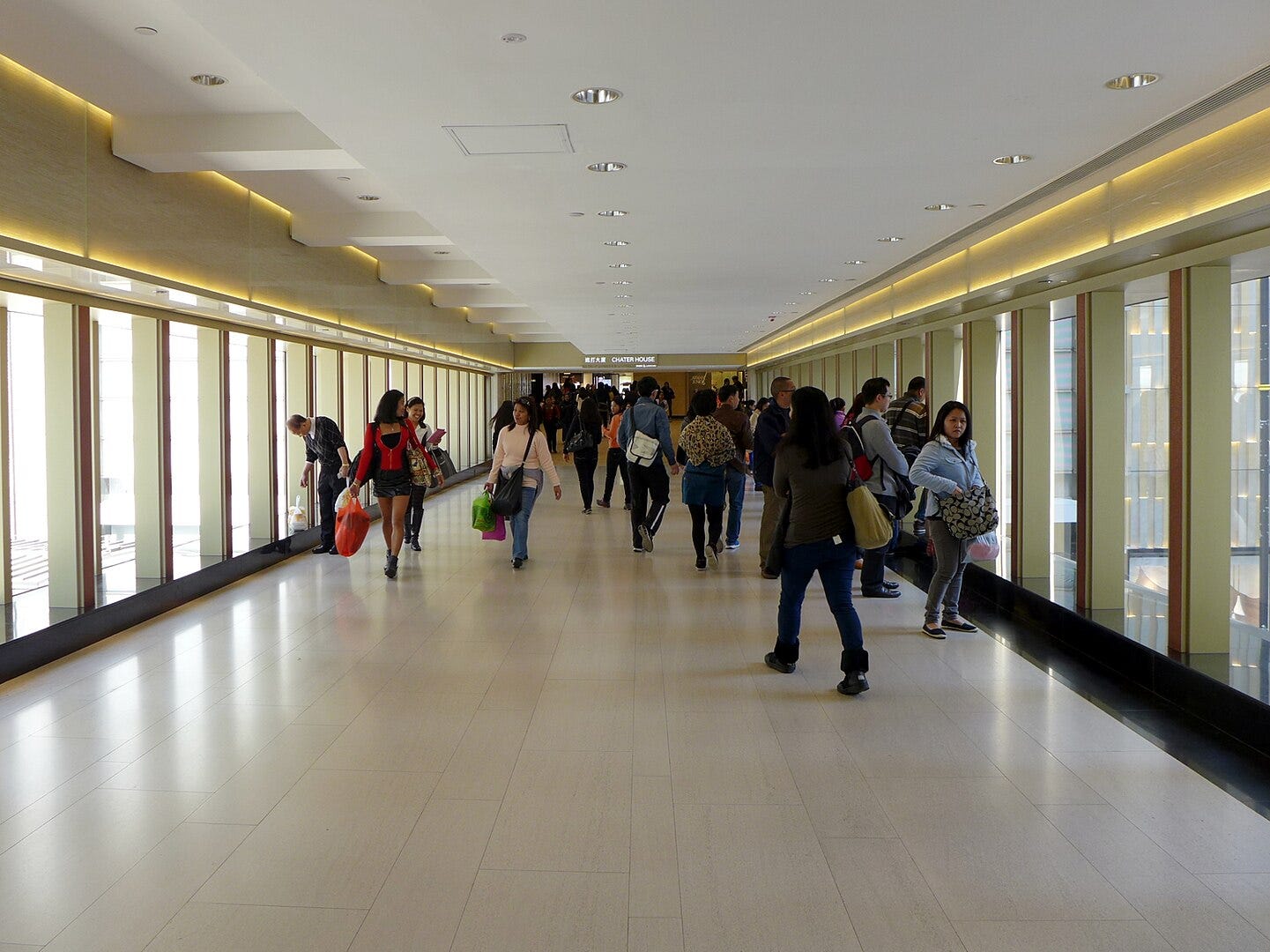Pedestrian bridges are mostly designed for cars, and we will be seeing more of them.
Get ready for a lot of fights about pedestrian rights.
Durham, in Northeast England, has many beautiful bridges. It has the most beautiful pedestrian bridge I have ever seen, the Kingsgate Bridge over the River Wear. It was the last structure designed personally by the brilliant engineer Ove Arup, and according to Arup, he considered it his finest work. According to Archdaily, he was so fond of it that he requested that his ashes be scattered from it after his death.
Durham also has what are possibly the worst pedestrian bridges I have ever seen, over a two-lane road that did not seem big or busy enough to merit it. I kept asking my host, architect Mark Siddall, what were they thinking? He could only shrug and note that it is busy during rush hour. There is an old joke that the only real function of a pedestrian bridge like this is to provide shade for the people running across the street under it, but they are not a joke; What are old people who have trouble climbing two flights of stairs, or young people pushing strollers, supposed to do?
I thought of Durham and these bridges after getting into a discussion about them on Linkedin, where a reader thought they were useful pedestrian infrastructure. In fact, they are not for people at all; they are for cars. As Joe Cortright wrote in City Observatory about so-called “pedestrian infrastructure:”
Much of what purports to be “pedestrian” infrastructure, is really car infrastructure, and is only necessary in a world that’s dominated by car travel, in places that are laid out to privilege cars. It’s telling that the “level of service” provided to pedestrians (nominally for their safety) would never be tolerated in any freshly built or “improved” highway project: The the ramps to reach overpasses double, triple or quadruple the distance a pedestrian must travel to cross a roadway, and require them to ascend and descend a substantial grade. No highway engineer would build a bypass that doubled or tripled travel times for cars, but they regularly do this for people on foot.
The bridges in Durham are ridiculous, and I can’t imagine many people using them. And when the old lady gets killed crossing the road, no doubt everyone says, “she should have used the overpass” instead of, “We should demolish the overpass and put in a traffic light.”
The Institute for Transportation and Development Policy (ITDP) complains about them too, noting that they do not encourage walkable, livable communities, nor do they improve road safety for drivers or cyclists.
Pedestrian bridges are structures built over roads that require people to take longer, often inaccessible routes up and over many lanes of car traffic, without impeding the speed or movement of vehicular traffic. Proponents of these structures argue that these bridges are made for the safety of pedestrians, by moving pedestrians out of the way of speeding cars. In reality, by displacing people, pedestrian bridges simply reinforce the dominion of vehicles over people on the streets. Pedestrian bridges discourage walking and cycling and worsen road safety for drivers, pedestrians, and cyclists. Separating people from the street reinforces the prioritization of personal motor vehicles, while encouraging speeding, driver negligence, and traffic fatalities.
The ITDP notes that pedestrian bridges increase the rate of fatalities and that many happen within a few hundred meters of the bridges because they give the drivers of cars “a sense of exclusive access to the road, and drivers are less likely to be aware of, or look for pedestrians.” They call instead for frequent, convenient and safe crossings at grade.
Be vigilant; We are going to see a lot more separation of pedestrians from cars as AVs proliferate.
I have been worrying about so-called pedestrian infrastructure since self-driving cars, or Autonomous Vehicles (AVs), showed up on the urban radar. I thought that AVs had gone away and that their hype cycle was over, and I agree with author Paris Marx that "the dream of ubiquitous autonomous vehicles that we were sold in the early and mid-2010s is not coming," but the dream is not totally dead. The California Public Utilities Commission recently approved the expansion of “robotaxis,” so driverless cars can now roam the streets of San Francisco. The supporters noted that 12 people die each day in vehicle collisions. According to Cal Matters,
In defense of self-driving cars, a representative from Mothers Against Drunk Driving, an orthopedic surgeon and bicycling enthusiasts argued that roads will be safer as human error-led accidents will decrease. Recalling incidents of harassment and discrimination, women and LGBTQ+ community members also pointed out the personal safety benefits of driverless cars. Lana Nieves, Independent Living Resource Center of San Francisco executive director: “Autonomous vehicle technology represents a future with greater independence, the ability to go where we want to go, when we want to go, and to do so on our own without having to get into a car with a complete stranger.”
With 70 million aging baby boomers mostly living in car-dependent suburbs, you can bet that these AV robotaxis are going to be everywhere soon. As Jane Gould wrote in "Aging in Suburbia: The Must-Have Conversation About Homes and Driving," the self-driving car (which she calls an SAV, or Shared Autonomous Vehicle) will be the answer to the boomers’ prayers.
If Boomers have a single opportunity to change the world in their retirement, it is in quickly adapting to this new mobility. The SAV may be able to transverse the vast, spread distances of the suburbs in a way that has never been economical or practical for public transportation.
The biggest problem the AV industry is going to face is the pedestrian who doesn’t like them taking over the roads. I think it is likely that by 2025 we will celebrate the 100th anniversary of the first ordinance against jaywalking in Los Angeles in 1925 with new laws; as Peter Norton wrote in Fighting Traffic:
“The ordinance codified pedestrians’ confinement to sidewalks and crossings , leaving to individual cities the choice of how far to go. At a minimum, cities adopting the ordinance would require pedestrians to yield the pavement to motorists everywhere except in a crosswalk. At their discretion, cities could require pedestrians to cross only at crosswalks , even in the absence of motor traffic.”
I suspect we will get Jaywalking 2.0 to make the roads safe for AVs. But laws won’t be enough; we will likely need physical separation. As Eric Taub wrote in the New York Times in a 2019 article titled How Jaywalking Could Jam Up the Era of Self-Driving Cars.
“If pedestrians know they’ll never be run over, jaywalking could explode, grinding traffic to a halt. One solution, suggested by an automotive industry official, is gates at each corner, which would periodically open to allow pedestrians to cross.”
Soon, the industry will be demanding fences, bridges and grade separation to ensure that unlawful and inconsiderate pedestrians never get near the road; it's the 20s and 30s all over again, where Norman Bel Geddes proposed a full separation of cars from pedestrians in his 1939 Futurama exhibit at the New York World’s Fair.
Given how hot our cities are getting, the grade separation might well be pitched as a pedestrian benefit, where you no longer have to be down on street level in the heat, breathing exhaust, but can be up above in air-conditioned comfort like they are in Central Hong Kong.
Am I taking a crazy leap from the discussion of a pedestrian bridge in Durham to full grade separation of people from cars? I don’t think so. They both serve the same purpose: to make the road safe for the unimpeded movement of cars, whether driven by humans now or robots soon. Let’s recognize them for what they are and prepare for much bigger battles.
From the archives:
I used to write a lot on Treehugger about self-driving cars and admired this Renault that you park in your living room. See my 2021 summary here: How will sel-driving cars change the way we live?












Just think Lloyd, pedestrian bridges may be your answer to pedestrian/bicyclist v Pick-up.
And you know that cannot be a bad thing.